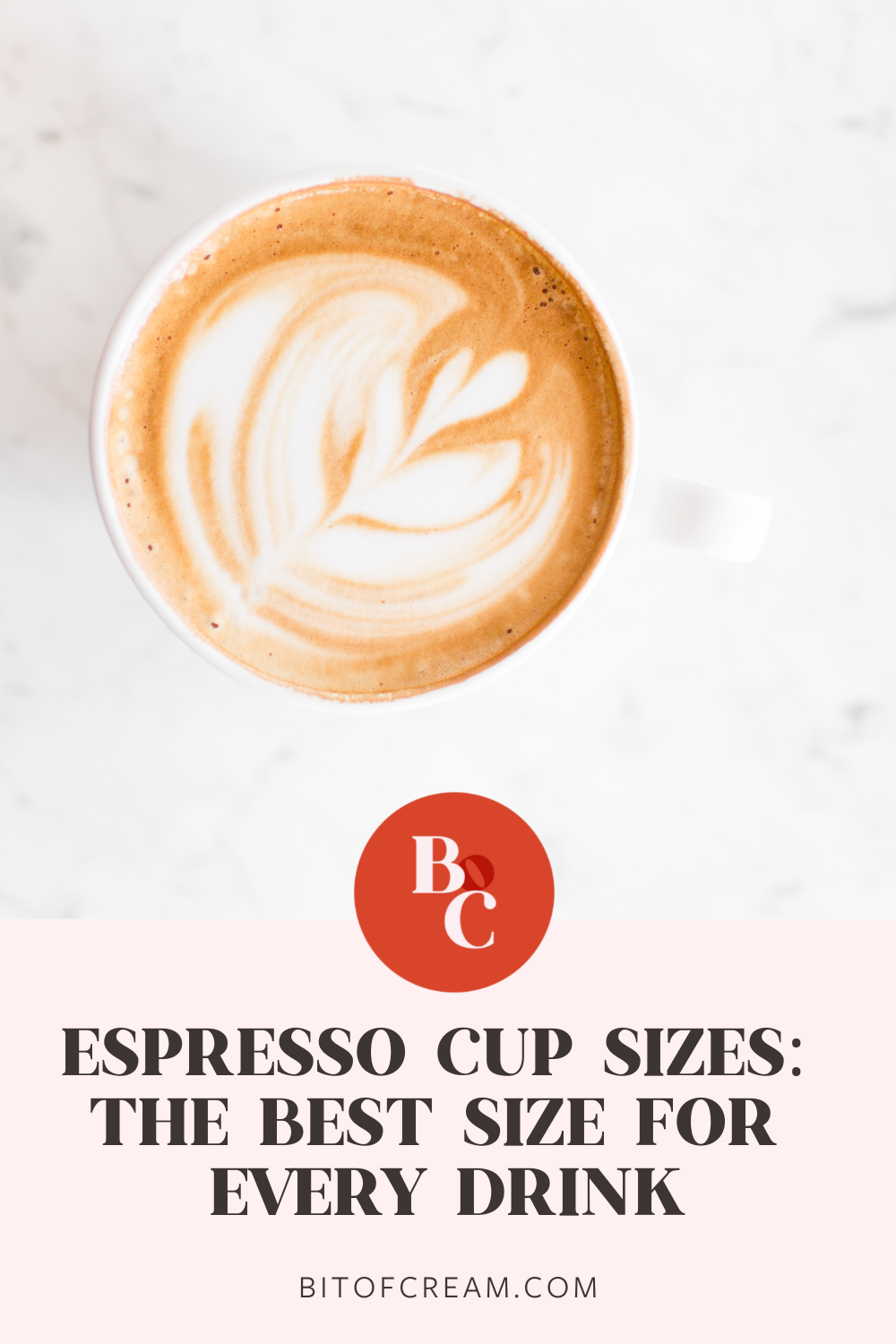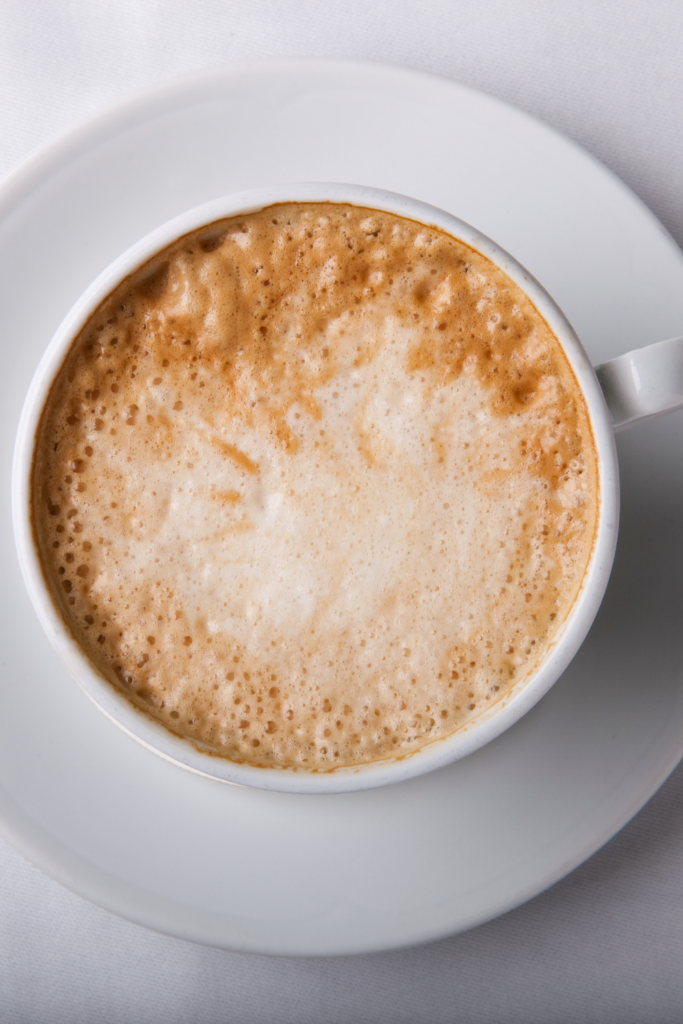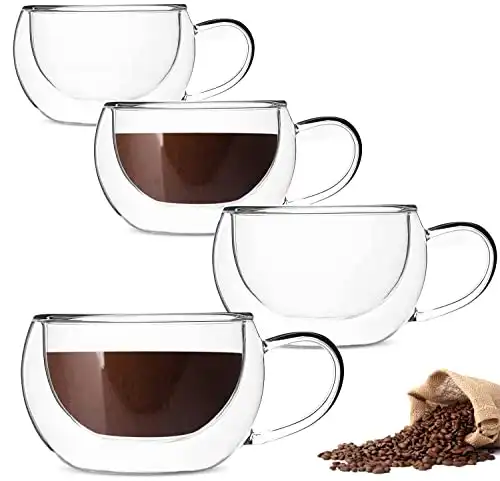Hey coffee lovers! Let’s chat about something you may have never thought about. Espresso cup sizes and the different sizes based on different espresso-based drinks.
First up, an espresso. An traditional espresso cup size holds 2.5-3 fluid ounces. It’s called a “demitasse,” and often comes with a small saucer to prop underneath the cup.
When you’re pulling singles or doubles, a standard ceramic demitasse is a perfect cup. But when shots get longer, or if you intend to add milk, you should reach for a different glass. Each espresso-based drink, from macchiato to latte, has its own cup size.
Whether you’re making your drinks at home or getting your drinks from local coffee shops, you’ll want to take note of the coffee mug size based on the coffee drink you’re getting!
In this article, I’ll explain why cup size is so important, what size you’ll need for various drinks, and what to look for when shopping for coffee cups.

This post includes affiliate links.
Espresso Shot Means Double
A 2-ounce shot of espresso is commonly referred to by the Italian word for double, “doppio.” And in this article, when I say “espresso shot” it’s in reference to a doppio, not a single.
After many years in the industry, I’ve found that a double is the industry standard for most drink recipes. Single shots are an exception to the norm, and they cause waste when baristas still have to pull doubles and dump the remaining espresso.
Size
You probably wouldn’t drink an espresso shot out of a cereal bowl. But if you did, it would go something like this.
- The base of the cereal bowl is wide, flattened, and exposed.
- As espresso pulls through the portafilter of your espresso machine and into the bottom of the bowl, the temperature of the espresso drops quickly because it’s exposed rather than insulated.
- As the shot spreads out to cover the bowl’s surface area, it oxidizes.
- The texture of the crema is lost, and suddenly you’re chasing the flavor of the shot, which is changing quickly.
Not great!
This is why we love demitasse cups. Its shape and size insulate the espresso and maintain the presentation of the shot with the crema resting on top. (Even after you give it a gentle stir.)
For milk-based espresso drinks, cup size impacts the feel and presentation of the drink. Latte art is harder to pull off if you don’t have the proper cup size.
Although all baristas pour differently, I’ve found that the larger sizes of the cup, the more difficult the pour. A cortado or macchiato limits the space you have to pour the rosetta or tulip – requiring more precision and concentration. The larger cup size is a slower pour which provides a greater margin for error.
Either way, if you try to pour a shorter drink, like a cappuccino into a latte cup, it can be harder to pull off the final image. That’s because you don’t have the cup’s rim as necessary resistance to your pour.
Regardless of your drink preferences, there’s are standard coffee cup sizes out there to suit your espresso needs.
Here’s the standard cup size for a variety of espresso based drinks.
| Cup Type | Drinks | Volume Ounces | Volume mL |
| Demitasse or Espresso | Espresso, Macchiato, Ristretto | 2.5-3 | 74-88 |
| Gibraltar | Lungo, Cortado | 4 | 88 |
| Cappuccino | Cappuccino, Flat White | 6 | 177 |
| Latte | Latte, Mocha | 12 | 354 |
Shape
Classic espresso cups should have curved bases inside the cup.
A curved base in your demitasse allows the espresso to blend more naturally and is a smoother sipping experience.
Think of going to a diner and sipping drip from a large white mug. The ceramic rim is super thick to keep the hot coffee insulated.
Since coffee is brewed hotter and is less dense than a latte, the thicker rim slows down the drinking experience.

The rims of espresso drinks are thinner. This allows the denser, milky drinks to pass smoothly over the rim for faster sipping. It’s okay that the cup isn’t “double” insulated.
*On that note, check out some of our favorite double walled coffee mugs here!
Lattes and milk-based drinks are meant to be consumed faster. This is because espresso and milk begin to separate over time and are served at a cooler temperature than brewed coffee.
Latte and cappuccino cups have a wider bowl-shaped cup size. The wide, open rim of cappuccino and latte mugs has the added benefit of being a great canvas for latte art practitioners.
Material
When it comes to espresso cups, I always opt for classic ceramic. They’re lightweight and provide the best pouring and sipping experience.
Depending on the drink you’re making, glass is also an option.
- Made of thicker mouth-blown, lab-quality borosilicate glass
- Each of glass mug holds 10ounces/300ML
Double-walled glass mugs improve heat retention. It’s also neat to see the coffee through the glass without burning your hands.
Gibraltar or cortado cups are made of glass. Cortados are small and meant to be consumed fast, and the thin glass cup makes it simple to down in a few sips.
Handle
The shape of the handle is less important for espresso shots and more important for milk-based espresso drinks.
I’ve been drinking and serving espresso for over a decade and never noticed any improvement from one demitasse handle to another. As long as it’s a 2.5-3 ounce cup, the handle shouldn’t impact the drink experience much.
While you pour latte art, it’s good form to use your thumb to grip the top of the cup’s handle. This keeps your arm at a right angle to your body and your arm from twisting too much.
If the handle of the latte cup is flat, it can be easier to rest your thumb and maintain a steady grip while you pour.
Recap
Espresso cups or “demitasses” are traditionally 2.5-3 ounce ceramic cups.
It’s best to look for espresso cups with curved bases that naturally mix and insulate the espresso in the cup for quick, seamless sipping.
Milk-based espresso drinks come in a variety of shapes and materials. I prefer to stick with the classic ceramic cups and their traditional sizes.
For example, a 4-ounce Gibraltar, a 6-ounce cappuccino, and so on.

Handles are only a consideration if you want to pour frequent latte art. A flat handle will be easier to grip while you pour milk, but it’s not a prerequisite for delicious coffee.
FAQ
A standard espresso is a “double shot,” or “shot,” is around 2 ounces.
This varies all the time depending on a barista’s chosen yield and the coffee they’re using.
Ristrettos are a “restricted” shot using less water, which results in a decreased yield. A lungo is a “long pull, “meaning more water is pushed through the coffee and increased yield.
Some refer to double shots as “doppios.” In my experience, most people refer to a double shot in the singular as “an espresso.” This is partly due to the changing standards of cafes, which more commonly default to a double shot rather than a single.
Espresso is a brewing method that requires pushing hot water at high pressure through a small puck of fresh ground coffee. This results in a highly concentrated beverage served in small doses. Espresso cups are the perfect size and shape to hold a shot of espresso.
A coffee cup refers to a cup meant for brewed or filtered coffee, like automatic drip or pour over. Since these are less concentrated brewing methods, the cup is bigger to accommodate more liquid. Anywhere from 8-16 ounces.
Now you know the standard size of espresso cups, check out some of my favorite espresso cups to choose from!
Free Coffee Art Printables
Don’t forget to get on the list before you go! You’ll get 3 free coffee art printables delivered when you sign up and weekly coffee tips and tricks, product reviews!

